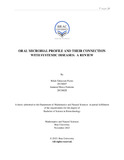| dc.contributor.advisor | Naser, Iftekhar Bin | |
| dc.contributor.author | Purno, Rifah Tabassum | |
| dc.contributor.author | Namrata, Jannatul Mawa | |
| dc.date.accessioned | 2024-04-30T10:14:34Z | |
| dc.date.available | 2024-04-30T10:14:34Z | |
| dc.date.copyright | © 2023. | |
| dc.date.issued | 2023-11 | |
| dc.identifier.other | ID 20136047 | |
| dc.identifier.other | ID 20136028 | |
| dc.identifier.uri | http://hdl.handle.net/10361/22708 | |
| dc.description | This thesis is submitted in partial fulfillment of the requirements for the degree of Bachelor of Science in Biotechnology and Bachelor of Science in Microbiology, 2023. | en_US |
| dc.description | Cataloged from PDF version of thesis. | |
| dc.description | Includes bibliographical references (pages 61-86). | |
| dc.description.abstract | In countries like Australia, Spain, the UK, and the USA, the interrelation of systemic diseases with oral microbes, has grabbed the attention of the experts. Oral microbes are the causative agents of several systemic diseases, such as Cancers (Pancreatic Cancer, Colon Cancer, Liver Cancer), Diabetes, Cardiovascular diseases (Stroke, Heart failure, Myocardial infarction, Endothelial dysfunction), RA, and Obesity by their nature of formation of biofilm or the growing usage of antibiotics and its resistance. According to a report by WHO in 2022, they evaluated that around 3.5 billion people are affected by oral diseases, among them 3 out of 4 people live in middle-income countries, such as Bangladesh. This review discussed the composition of oral microbes and their habitats where they reside in a biofilm form, which enables them to interact with each other and facilitate them to interact with other systems of the body. Additionally, excessive usage of several drugs has caused the induction of resistance to several antibiotics by different oral microbes and these resistances are achieved by different approaches. Moreover, specific bacteria work in systemic and oral diseases, targeting those oral microbes, and different kinds of therapeutic approaches were selected. It was concluded with the correlating antibiotic usage in Bangladesh and other countries, along with their increased antibiotic resistance, which can be anticipated from the reviewed data that Bangladesh could resemble antibiotic resistance like other countries, and the excessive usage of antibiotics could lead to increased correspondence to systemic diseases | en_US |
| dc.description.statementofresponsibility | Rifah Tabassum Purno, Jannatul Mawa Namrata | |
| dc.description.statementofresponsibility | Jannatul Mawa Namrata | |
| dc.format.extent | 104 pages | |
| dc.language.iso | en | en_US |
| dc.publisher | Brac University | en_US |
| dc.rights | Brac University theses are protected by copyright. They may be viewed from this source for any purpose, but reproduction or distribution in any format is prohibited without written permission. | |
| dc.subject | Oral microbial profile | en_US |
| dc.subject | Systemetic diseases | en_US |
| dc.subject.lcsh | Microbial Interactions. | |
| dc.title | Oral microbial profile and their connection with systemic diseases: a review | en_US |
| dc.type | Thesis | en_US |
| dc.contributor.department | Department of Mathematics and Natural Sciences, Brac University | |
| dc.description.degree | B. Biotechnology | |

